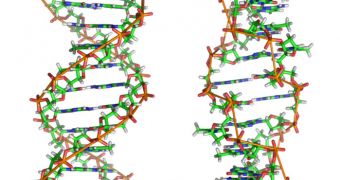A group of investigators at the University of Rochester, in the United Kingdom, announces the discovery of a protein that appears to play an important role in promoting DNA repair in cells. The molecule is apparently present in smaller amounts when the cells get older.
A long time ago, researchers discovered that living cells can regenerate themselves, and repair their deoxyribonucleic acid (DNA) reserves. Still, during the normal aging process, the body gradually loses the ability to repair the DNA helices, which eventually leads to fatal degradation.
Since making this discovery, experts have been trying to discover the mechanisms involved in this process, but only a small progress was ever made. The UK team now believes it has more answers.
Biologists Andrei Seluanov, Vera Gorbunova, Zhiyong Mao, Xiao Tian, Michael Van Meter, and Zhonghe Ke say that a protein present in cells during DNA repair appears to diminish in quantity as the latter age. This decline has a significant effect on the repair processes.
In a paper published in the latest issue of the esteemed journal Proceedings of the National Academy of Sciences (PNSA), the investigators explain that a failure of the repair mechanism favors the emergence of tumors, at the same time reducing the overall functionality of tissues.
Investigations of DNA repair patterns have revealed that boosting the concentration of a protein called SIRT6 can reverse the effects of aging, and enable the body to take care of the genome effectively.
What is really surprising about this work is that it's possible for the entire aging process to be the result of how much of a single protein is present in the body. If so, prolonging human life would simply be a matter of boosting SIRT6 concentrations when they drop below a certain level.
Previous studies “showed that overexpressing the SIRT6 protein extended the lifespans of mice. Our research looked at DNA repair and found a reason for the increased longevity, and that is SIRT6′s role in promoting more efficient DNA repair,” Gorbunova explains, quoted by Science Blog.
Interestingly, the molecule is involved in repairing the most dangerous type of DNA damage: double-strand breaks, while leaving other types of damages largely untouched. Therefore, combining it with other molecules that promote repair could turn out to be a good idea.

 14 DAY TRIAL //
14 DAY TRIAL //